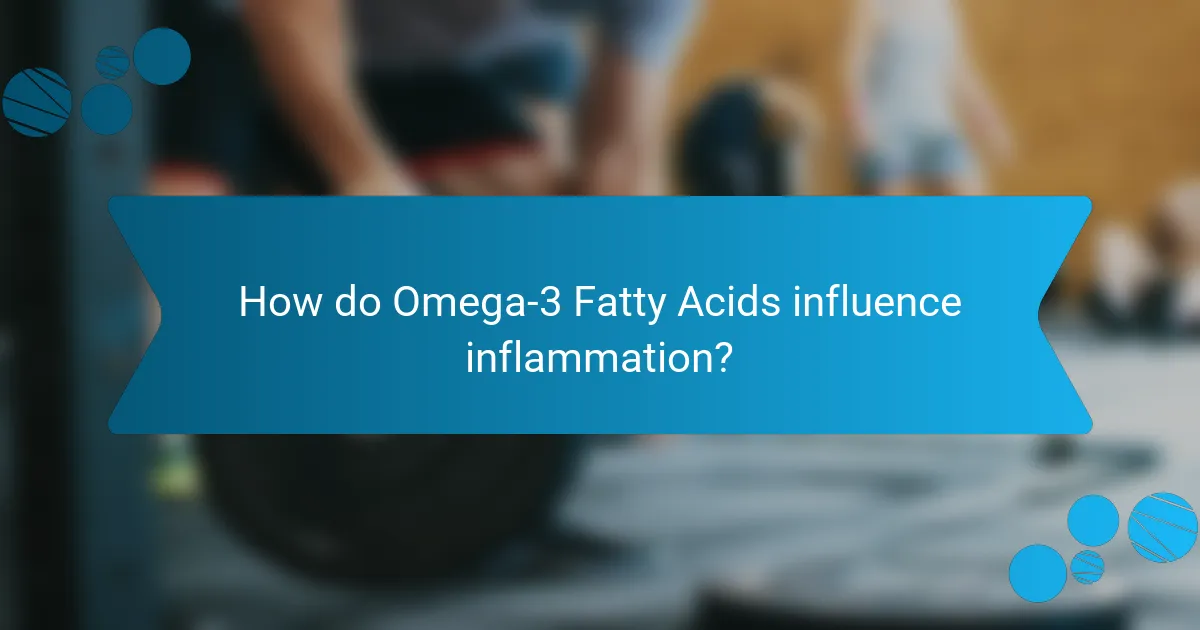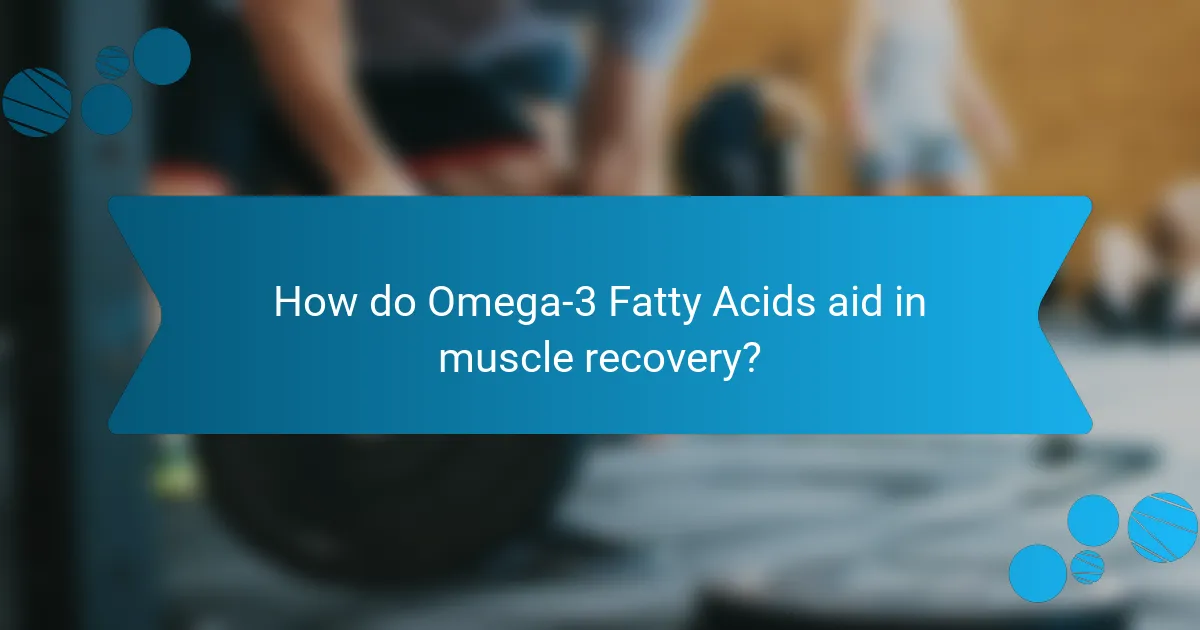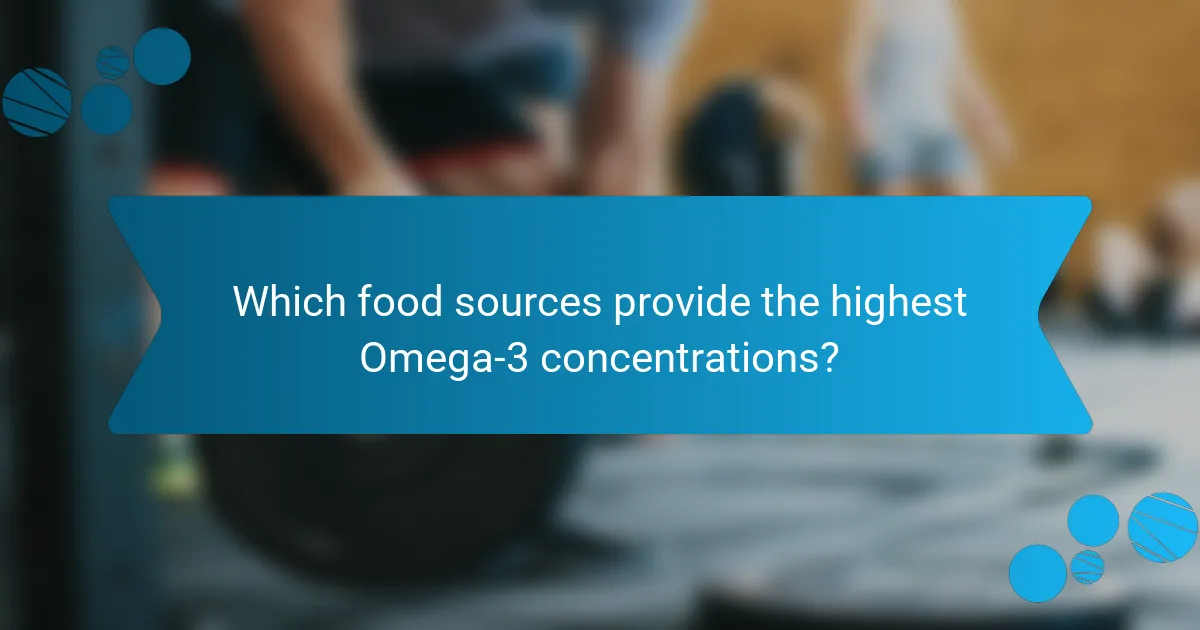Omega-3 fatty acids are essential for reducing inflammation and enhancing muscle recovery. They lower pro-inflammatory cytokines and promote cellular repair. This article explores how omega-3 supplementation aids in post-exercise recovery, identifies key dietary sources, and outlines recommended dosages for optimal benefits. Additionally, it highlights the broader health advantages of omega-3s beyond muscle recovery.

How do Omega-3 Fatty Acids influence inflammation?
Omega-3 fatty acids significantly reduce inflammation, promoting muscle recovery. These essential fats lower pro-inflammatory cytokines and increase anti-inflammatory mediators. Research shows that omega-3 supplementation can enhance recovery post-exercise, reducing muscle soreness and improving performance. For instance, a study indicated that athletes supplementing with omega-3s experienced less inflammation and faster recovery times.
What are the mechanisms behind Omega-3’s anti-inflammatory effects?
Omega-3 fatty acids reduce inflammation through multiple mechanisms. They modulate immune cell function, decreasing pro-inflammatory cytokine production. Omega-3s also promote the synthesis of anti-inflammatory mediators, such as resolvins and protectins. Additionally, they improve endothelial function, enhancing blood flow and reducing tissue inflammation. These effects collectively support muscle recovery and overall health.
Which studies support Omega-3’s role in reducing inflammation?
Research supports Omega-3 fatty acids’ role in reducing inflammation through various studies. For instance, a meta-analysis published in the Journal of Nutrition found significant reductions in inflammatory markers like C-reactive protein and interleukin-6 among participants consuming Omega-3 supplements. Another study in the American Journal of Clinical Nutrition demonstrated that Omega-3 intake improved muscle recovery post-exercise by decreasing muscle soreness and enhancing protein synthesis. Additionally, a randomized controlled trial indicated that Omega-3 supplementation led to lower levels of inflammatory cytokines in patients with chronic inflammatory conditions. These findings highlight Omega-3’s unique anti-inflammatory properties and their potential benefits for muscle recovery.

How do Omega-3 Fatty Acids aid in muscle recovery?
Omega-3 fatty acids significantly aid in muscle recovery by reducing inflammation and promoting cellular repair. They enhance the body’s anti-inflammatory response, which is crucial after intense exercise. Research shows that omega-3s can decrease muscle soreness and improve recovery time, allowing athletes to train more effectively. Additionally, their unique property of promoting protein synthesis supports muscle growth and repair.
What is the timeline for muscle recovery with Omega-3 supplementation?
Muscle recovery with Omega-3 supplementation typically occurs within 24 to 72 hours post-exercise. Omega-3 fatty acids reduce inflammation, promoting faster healing. Research indicates that consistent intake can enhance recovery speed, especially in athletes. The unique attribute of Omega-3s is their ability to modulate inflammatory responses effectively.
How do Omega-3s compare to other supplements for muscle recovery?
Omega-3 fatty acids are more effective for muscle recovery compared to many other supplements due to their anti-inflammatory properties. Research indicates that omega-3s can significantly reduce muscle soreness and enhance recovery time after intense exercise. In contrast, supplements like creatine and branched-chain amino acids (BCAAs) primarily support muscle growth rather than recovery. Omega-3s uniquely improve joint health and overall inflammation, which can be beneficial for athletes. Additionally, their bioavailability is often higher than that of other supplements, leading to quicker and more effective absorption.

Which food sources provide the highest Omega-3 concentrations?
Fatty fish provide the highest concentrations of Omega-3 fatty acids. Salmon, mackerel, sardines, and anchovies are prime sources, offering significant health benefits. For instance, a 3.5-ounce serving of salmon contains approximately 2,260 mg of Omega-3s. Other sources include flaxseeds, chia seeds, and walnuts, which also contribute to Omega-3 intake but in lower concentrations compared to fish.
What are the differences between plant-based and marine sources of Omega-3?
Plant-based Omega-3 sources, such as flaxseed and chia seeds, primarily provide alpha-linolenic acid (ALA), while marine sources, like fish oil, offer eicosapentaenoic acid (EPA) and docosahexaenoic acid (DHA). ALA must be converted to EPA and DHA in the body, which is less efficient. Marine sources are often considered more effective for reducing inflammation and enhancing muscle recovery due to their higher bioavailability of EPA and DHA. Additionally, marine sources may contain unique attributes like antioxidants and vitamins not found in plant-based sources.
How can dietary choices impact Omega-3 intake in different regions?
Dietary choices significantly influence Omega-3 intake across regions. Regions with high fish consumption, such as coastal areas, tend to have elevated Omega-3 levels. In contrast, landlocked regions may rely on plant-based sources like flaxseed and walnuts, which provide ALA, a precursor to EPA and DHA.
Cultural dietary habits further affect Omega-3 availability. For instance, Mediterranean diets rich in fatty fish lead to better inflammation control and muscle recovery. In contrast, Western diets high in processed foods often lack sufficient Omega-3, impacting health outcomes.
Overall, regional dietary patterns dictate the sources and types of Omega-3 fatty acids consumed, ultimately affecting health and recovery processes.

What are the recommended dosages of Omega-3 Fatty Acids for inflammation and recovery?
The recommended dosages of Omega-3 Fatty Acids for inflammation and recovery range from 1,000 to 3,000 mg per day. Higher doses may be beneficial for individuals with specific inflammatory conditions. Omega-3s, particularly EPA and DHA, have been shown to reduce inflammation and improve muscle recovery after exercise. Studies indicate that a daily intake of 2,000 mg can enhance recovery and decrease muscle soreness. Always consult a healthcare provider before starting new supplements to determine the appropriate dosage for individual needs.
How do dosage recommendations vary by individual needs?
Dosage recommendations for omega-3 fatty acids vary based on individual needs such as age, health status, and specific health goals. Factors influencing dosage include body weight, dietary intake, and existing medical conditions. For example, athletes may require higher doses to support muscle recovery, while individuals with inflammatory conditions may benefit from targeted supplementation. Personalization ensures optimal effects on inflammation and muscle recovery.
What potential side effects should be considered with high Omega-3 intake?
High Omega-3 intake can lead to side effects such as increased bleeding risk, gastrointestinal issues, and changes in blood sugar levels. Excessive consumption may also cause a fishy aftertaste or bad breath. Monitoring intake is essential to avoid these complications.

What role do Omega-3 Fatty Acids play in overall health beyond inflammation and recovery?
Omega-3 fatty acids support overall health through various mechanisms beyond inflammation and recovery. They enhance cardiovascular health by lowering triglycerides and reducing blood pressure. Omega-3s also improve brain function, potentially lowering the risk of cognitive decline. Additionally, they promote eye health by supporting retinal function. These benefits stem from unique attributes like their ability to influence cell membrane fluidity and function.
How do Omega-3s contribute to cardiovascular health?
Omega-3 fatty acids significantly improve cardiovascular health by reducing inflammation and promoting healthy blood circulation. They lower triglyceride levels, decrease blood pressure, and improve endothelial function. Research indicates that regular intake of omega-3s can lead to a 20-30% reduced risk of heart disease. Unique attributes of omega-3s include their ability to enhance heart rhythm stability and reduce arterial plaque formation.
What are the cognitive benefits associated with Omega-3 consumption?
Omega-3 fatty acids enhance cognitive function by improving memory and reducing inflammation. Research shows that omega-3s support brain health, potentially lowering the risk of cognitive decline. They promote neurogenesis and synaptic plasticity, which are vital for learning and memory retention. Additionally, omega-3 consumption is linked to improved mood and reduced symptoms of depression, contributing to overall cognitive well-being.

How can individuals optimize their Omega-3 intake for maximum benefits?
To optimize Omega-3 intake for maximum benefits, individuals should focus on dietary sources and supplementation. Consuming fatty fish like salmon, mackerel, and sardines provides high levels of EPA and DHA, essential for reducing inflammation and enhancing muscle recovery.
Incorporating plant-based sources such as flaxseeds, chia seeds, and walnuts offers ALA, which the body can partially convert to EPA and DHA. Aim for at least two servings of fatty fish per week or consider high-quality Omega-3 supplements if dietary intake is insufficient.
Monitoring Omega-3 levels through blood tests can help ensure adequate intake, guiding adjustments as needed. Combining these strategies fosters optimal benefits for inflammation reduction and muscle recovery.
What are the best practices for incorporating Omega-3s into a daily routine?
Incorporating Omega-3s into a daily routine can enhance inflammation reduction and muscle recovery. Start by including fatty fish like salmon or mackerel in meals at least twice a week. Consider using flaxseed oil or walnuts as plant-based sources. Supplementation with high-quality Omega-3 capsules can be effective if dietary sources are insufficient. Aim for a daily intake of 250-500 mg of combined EPA and DHA for optimal benefits.
Which common mistakes should be avoided when using Omega-3 supplements?
Common mistakes to avoid when using Omega-3 supplements include taking inadequate dosages, neglecting to check for contaminants, and ignoring the balance with Omega-6 fatty acids. Many users underestimate the importance of consistency in intake, which can hinder inflammation reduction and muscle recovery. It’s crucial to choose high-quality supplements that specify their EPA and DHA content, as these unique attributes significantly influence effectiveness. Additionally, some individuals may overlook the timing of intake, which can impact absorption and overall benefits.